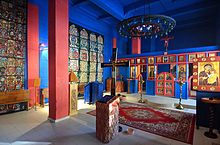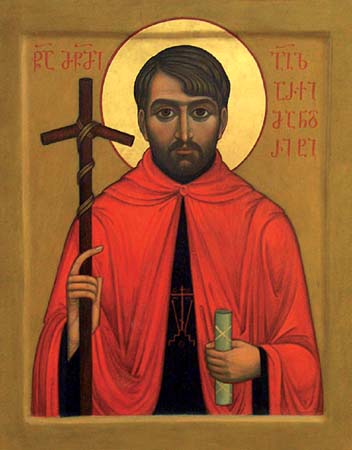 Περίληψη στα ελληνικά: Ο άγιος ιερομάρτυρας Γκριγκόλ (Γρηγόριος) Περάτζε (1899-1942) ήταν ένας σπουδαίος Γεωργιανός πανεπιστημιακός θεολόγος, ιστορικός και ορθόδοξος ιερομόναχος (αρχιμανδρίτης).
Περίληψη στα ελληνικά: Ο άγιος ιερομάρτυρας Γκριγκόλ (Γρηγόριος) Περάτζε (1899-1942) ήταν ένας σπουδαίος Γεωργιανός πανεπιστημιακός θεολόγος, ιστορικός και ορθόδοξος ιερομόναχος (αρχιμανδρίτης).Σπούδασε και δίδαξε σε διάφορες ευρωπαϊκές χώρες. Ο Β΄ Παγκόσμιος Πόλεμος τον βρήκε στην Πολωνία, όπου άρχισε δράση για την προστασία των διωκόμενων Εβραίων. Το Μάιο του 1942 συνελήφθη από τους Ναζί και κατέληξε στο Άουσβιτς. Εκεί, αν και αθώος, ανέλαβε την ευθύνη για το θάνατο ενός Γερμανού αξιωματικού, για να προστατεύσει τους κρατούμενους από τα βασανιστήρια (τους είχαν βγάλει γυμνούς στο ψύχος). Τότε οι Ναζί τον έκαψαν ζωντανό.
Η Ορθόδοξη Εκκλησία της Γεωργίας τον αναγνώρισε ως άγιο το 1995. Γιορτάζει στις 6 Δεκεμβρίου, ημέρα του μαρτυρίου του.
Άλλους αγίους νεομάρτυρες από τους Ναζί δες στο τέλος της ανάρτησης.
OrthodoxWiki
Holy Hieromartyr Grigol Peradze was a famous Georgian ecclesiastic figure, theologian, historian, archimandrite, Doctor of History, and Professor of the early twentieth century. Like Christ Himself, Archimandrite Grigol died for having taken upon himself the sin of another. His feast day is December 6.
Life
Archimandrite Grigol Peradze was born on August 31, 1899 in the village of Bakurtsikhe, in the Sighnaghi district of Kakheti, in Eastern Georgia. His father, Romanoz Peradze, was a priest.
 |
| Photo from here |
Initially, Grigol studied theology and eastern languages at the University of Berlin from 1922 to 1925. In 1925, he transferred to the University of Bonn from which he graduated in 1927 with a doctoral degree in Philosophy, awarded for his dissertation History of the Georgian Monasticism from its creation until 1064. He also attended lectures in theology at the University of Louvain until 1927.
In early 1927, Grigol moved to England to continue his academic career. In England he found in the library collections of the British Museum and Oxford University old patristic manuscripts. In July 1927, he was named an Associate Professor at the University of Bonn, to which he returned to lecture on the history of Georgian and Armenian literature until 1932.
In 1931, Grigol Peradze entered a monastic life and was tonsured a monk. He was then ordained a priest in the Greek Orthodox Cathedral of London and was appointed dean of the St. Nino Georgian Orthodox church in Paris. Also in 1931 he began to publish a Georgian scientific journal titled "Jvari Vazisa" ("Cross of Vine").
At the invitation of Orthodox Metropolitan Dionysius Waledinsky of All Poland in 1932, Grigol taught until 1934 at the Faculty of Orthodox Theology of Warsaw University in Poland as a Professor of Patrology. In 1934, he also received the rank of archimandrite.
Throughout the 1930s, Archim. Grigol continued his search for manuscripts concerning Georgian Christian culture. He discovered many in Romania, Bulgaria, Greece, Italy, Germany, and Austria. These included manuscripts of the Typikon of the Georgian Petritsoni Monastery (Bachkovo, Bulgaria), the so-called Tischendorf manuscripts of the Apagae of the Monastery of the Holy Cross at the University Library in the University of Leipzig, Germany, as well as others.
The invasion of Poland by German troops in 1939 made Archim. Grigol's position in Poland precarious, for his being in solidarity with Jews in peril went without saying. He helped wherever he could. He did not hesitate to visit the imprisoned Polish Metr. Dionysius. These activities were viewed with growing suspicion by the Nazi occupiers and brought Archim. Grigol's fruitful ecclesiastic and scientific activities to an end.
On May 4, 1942, he was arrested by the German Gestapo for sheltering and aiding Jews and other victims of fascist persecutions. The priceless collection of Georgian manuscripts he had collected (in hopes of returning them to Georgia) disappeared a search of his quarters. Initially, incarcerated in Pawiak prison in Warsaw, he was deported to Auschwitz in November 1942.
At Auschwitz, a German officer was killed by one of the inmates. To get a confession, the guards drove everyone out of the barracks completely naked into the below freezing weather. To save the innocent prisoners from freezing to death, Archim Grigol chose to take the blame for the murder. Upon his admission the guards let loose dogs on the [martyr], then poured gasoline over him, and lit him on fire.
It was on December 6, 1942, at 4:45PM, that Grigol Peradze was martyred in the Nazi concentration camp of Auschwitz. In the end, like Christ Himself, Archimandrite Grigol died for having taken upon himself the sin of another.
Grigol Peradze was glorified by the Georgian Orthodox and Apostolic Church in 1995.

The interior of the Orthodox chapel
Principal scientific works by Grigol Peradze
The main fields of scientific activity of Grigol Peradze were: the history of the Georgian Orthodox and Apostolic Church, source studies of the history of Georgia and the Georgian Church, Patrology, history of Georgian literature, and Rustvelology (Shota Rustaveli a great Georgian poet of the 12th century).
- Die Anfänge des Mönchtums in Georgien.- "Zeitschrift für Kirchengeschichte", 47, Heft 1, Stuttgart, 1928, pp. 34-75 (in German)
- L'activité littéraire des moines géorgiens au monastère d'Iviron au mont Athos.- "Revue d'histoire ecclésiastique", 27, Fasc. 3, Paris, 1927, pp. 530-539 (in French)
- Über das georgische Mönchtum.- "Internationale Kirchliche Zeitschrift", 34, Heft 3, Bern, 1926, pp. 152-168 (in German)
- Die Probleme der ältesten Kirchengeschichte Georgiens.- "Oriens Christianus", 29, Bd. 7, Wiesbaden, 1932, pp. 153-171 (in German)
- Zur vorbyzantinischen Liturgie Georgiens.- "Le Museon", 42, Fasc. 2, Louvain, 1929, pp. 90-99 (in German)
- Les Monuments liturgiques prébyzantins en langue géorgienne.- "Le Museon", 45, Fasc. 4, Louvain, 1932, pp. 255-272 (in French)
- The Liturgy of Saint Peter.- "Kyrios", 2, Fasc. 3, 1937, pp. 260-262
- An Account of the Georgian Monks and Monasteries in Palestine as revealed in the Writings of Nongeorgian Pilgrims.- "Georgica", 2, Vol. 4-5, London, 1937, pp. 181-246
- Über die Georgischen Handschriften in Österreich.- "Wiener Zeitschrift für die Kunde des Morgenlandes", 47, Heft 3-4, Wien, 1940, pp. 219-232 (in German)
- Im Dienste der Georgischen Kultur.- "Aus der Welt des Ostens", Königsberg, 1940, pp. 30-50 (in German)
 |
| Icon from here |
Literature about Grigol Peradze
- Victor Nozadze. "Grigol Peradze".- Georgian journal "Mamuli", Buenos-Aires, No 5, 1952
- Tamar Dularidze. About the life and death of Grigol Peradze.- "Russkaia Misl", New York, 13-19.VII, 1995 (In Russian)
- "Artanuji" (The Georgian historical scientific journal), Tbilisi, No 11, 2003 (Special issue: Grigol Peradze), 120 pp (In Georgian)
- David Kolbaia (editor) "St. Grigol (Peradze) works nr 1, in: Pro Georgia Journal of Kartvelological Studies nr 13, 200.
See also:
Not often you see a Nazi serpent in an icon
Holy New Martyrs of Jasenovac Concentration Camp
Orthodox Holiness - The New Martyrs of Bosnia
The Miracle of Saint Menas in El Alamein in 1942
Saint Ekvtime Taqaishvili of Georgia, the Man of God (1863-1953)
Saint Ekvtime Taqaishvili of Georgia, the Man of God (1863-1953)
Δεν υπάρχουν σχόλια:
Δημοσίευση σχολίου